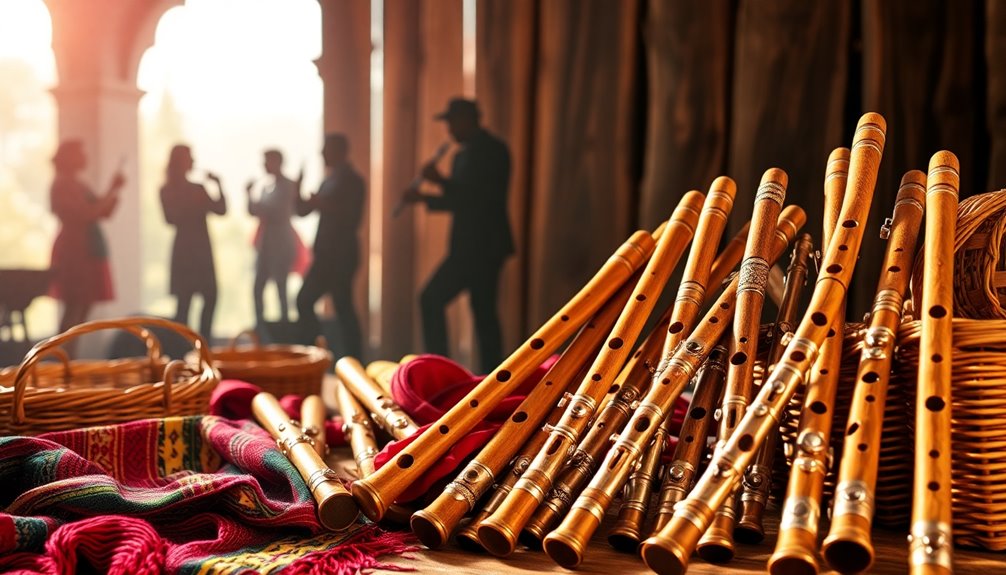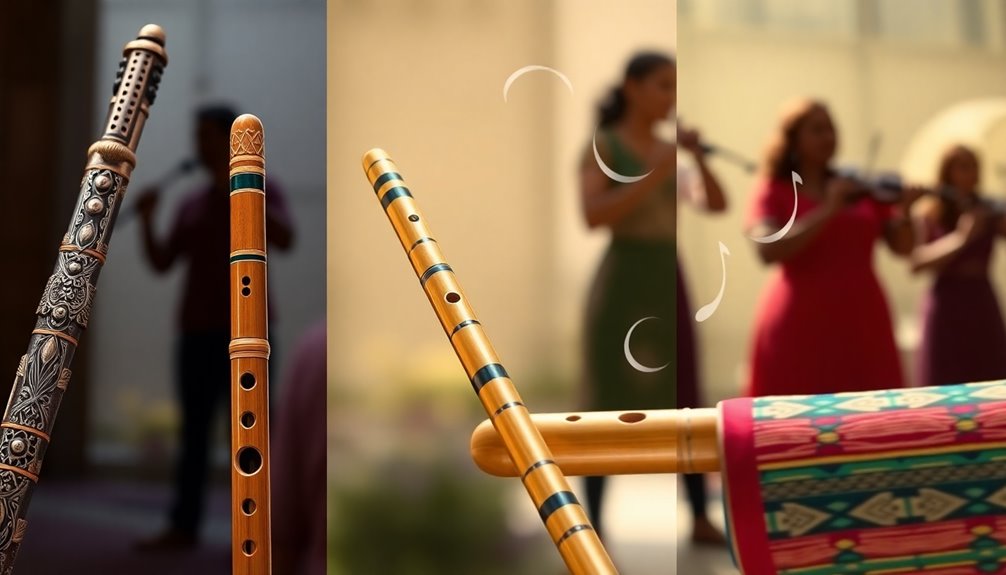When exploring flutes in folk music, you'll discover their deep connection to cultural identity and storytelling across the globe. From the bamboo flutes of Asia that bridge generations to the wooden flutes of Ireland leading traditional jigs, each type reflects unique narratives. In Africa, flutes serve as tools for communal storytelling, while Indigenous flutes in the Americas connect people to their land through ceremonies. The evolution of flute construction also highlights how these instruments adapt to contemporary sounds, enriching today's musical landscapes. There's much more to uncover about these enchanting instruments and their evolving roles in global folk traditions.
Key Takeaways
- Flutes have ancient origins and serve as vital instruments in storytelling and community bonding across various cultures worldwide.
- Bamboo flutes in Asia and wooden flutes in Ireland are essential for preserving traditional melodies and connecting generations through music.
- African flutes embody cultural identity, utilizing local materials to represent unique landscapes and contribute to communal storytelling practices.
- Indigenous flutes in the Americas play crucial roles in ceremonies, reflecting cultural expressions and preserving ancestral stories linked to the land.
- Contemporary music incorporates flutes, blending traditional sounds with genres like jazz and electronic, enriching storytelling and enhancing global musical dialogues.
Historical Overview of Flutes

When you explore the historical overview of flutes, you'll discover that these instruments have a rich and diverse heritage spanning across cultures and centuries. The ancient flute origins trace back to prehistoric times, with evidence found in archaeological sites across Europe and Asia. Early flutes were crafted from materials like bone and wood, reflecting the resources available to different cultures. This adaptability showcases the flute's fundamental role in human expression.
Flutes have held significant historical significance, serving not just as musical instruments but as tools for storytelling, ritual, and community bonding. In ancient civilizations, flutes often accompanied sacred ceremonies, allowing people to connect with their spirituality and each other.
As you investigate deeper, you'll notice how the design and construction of flutes evolved, influenced by geographical factors and cultural exchanges. The variety of flutes, such as the Western Concert Flute, highlights the instrument's adaptability and evolution over time.
Through fieldwork, you can appreciate how flutes symbolize unity and identity. Each culture adds its unique voice to the flute's narrative, creating an intricate tapestry of sound.
Flutes in Asian Folk Traditions

Across Asia, flutes play an essential role in folk traditions, weaving together music, culture, and storytelling in a variety of unique forms. When you explore the diverse landscapes of this vast continent, you'll find bamboo flutes being skillfully crafted and played in communities ranging from the bustling markets of India to the serene villages in China. Each flute, with its distinct sound, carries the weight of history and tradition.
In many cultures, these bamboo flutes serve as a bridge between generations. You might hear them accompanying traditional melodies that narrate tales of love, nature, and life itself.
For instance, in Japan, the shakuhachi flute not only produces hauntingly beautiful sounds but also embodies Zen philosophy, inviting listeners to reflect deeply. Meanwhile, in Southeast Asia, flutes often accompany rituals, enhancing the spiritual atmosphere during ceremonies. Additionally, the choice of high-quality woods in crafting flutes influences their tonal qualities and durability, reflecting the craftsmanship behind these instruments.
As you immerse yourself in these traditions, you'll discover the connection between the flute's voice and the heart of the community. The melodies resonate with shared experiences, fostering a sense of belonging and continuity, reminding you that music is a universal language that transcends boundaries.
European Flute Varieties and Styles

European folk music showcases a rich tapestry of flute varieties and styles, each rooted in distinct cultural traditions and historical contexts.
You'll find that the Irish wooden flute, with its warm timbre, plays an essential role in Celtic traditions, often leading lively jigs and haunting ballads. Meanwhile, Renaissance recorders, with their sweet yet piercing sound, transport you to the courts of the past, blending seamlessly in folk ensembles.
The Pan flute, celebrated across various European regions, creates enchanting harmonies that echo Balkan melodies, inviting you to experience the communal spirit of traditional celebrations.
In contrast, Medieval flutes, typically made from wood and lacking keys, offer a raw and unrefined sound that connects you to the early roots of folk music.
You'll notice Baroque influences as well, where flutes evolved into more sophisticated instruments, enriching the folk repertoire. The concert flute's versatility allows it to adapt to various folk styles, enhancing performances across different genres.
Each style and variety reflects not just the technical aspects but the cultural essence and shared stories of communities.
Whether you're playing or listening, these flutes invite you to explore, connect, and belong to a vibrant tradition that transcends borders.
African Flutes and Cultural Significance

Flutes in Africa serve not just as musical instruments but as powerful symbols of cultural identity and communal storytelling. When you explore the craftsmanship behind African flutes, you'll uncover rich traditions and techniques passed down through generations. Artisans skillfully create these instruments from locally sourced materials, reflecting the unique landscapes and cultures of their communities.
As you listen to traditional flute melodies, you'll notice how they convey emotions, narrate stories, and celebrate life events. Each note resonates with the history and values of the people, connecting you to their experiences. These melodies often accompany rituals, dances, and gatherings, reinforcing social bonds and shared heritage.
In various African cultures, flutes play an essential role in education and cultural preservation. They teach younger generations about their roots and instill a sense of belonging. Additionally, the use of bamboo in flute construction enhances the sound quality(https://example.com) and reflects the natural connection to the environment.
As you immerse yourself in this world, you'll recognize that the music isn't just about sound; it's a living expression of identity. The intricate craftsmanship and evocative melodies remind you that each flute tells a story, inviting you to engage with Africa's rich tapestry of cultural narratives.
Indigenous Flutes in the Americas

Indigenous communities in the Americas have long embraced the flute as an essential instrument in their cultural expressions and spiritual practices. The flute isn't just an object; it's a vessel of storytelling, connection, and identity.
You'll find a rich tapestry of flutes, each resonating with its unique sound and cultural significance.
- Native American Flutes: Often made from wood or bone, these flutes play a crucial role in ceremonies and healing practices, connecting the player to the spirit world.
- Andes Flute: In the Andes, flutes like the zampoña are integral to traditional music, echoing the rhythms of the mountains and the lives of the people.
- Cultural Significance: The act of playing the flute transcends mere music; it's a way for Indigenous peoples to preserve their stories, beliefs, and connection to the land. Additionally, many Indigenous musicians often select beginner-friendly features that enhance their playing experience and connection to tradition.
These flutes embody Indigenous traditions, echoing the voices of ancestors and fostering community.
When you listen to these melodies, you're not just hearing notes; you're experiencing a profound legacy that invites you to feel a sense of belonging in a shared human experience.
Contemporary Uses of Flutes

In today's diverse musical landscape, the flute continues to find its place within both traditional and contemporary genres, bridging past and present in unique ways. You might notice this in how jazz flutes have evolved, enriching the improvisational spirit of jazz with their melodic versatility.
Musicians like Herbie Mann and Yusef Lateef brought the flute to the forefront, showcasing its ability to express complex emotions and narratives. As you explore jazz, you'll find flutes weaving seamlessly into ensembles, offering a voice that's both soothing and dynamic.
Meanwhile, digital flutes are pushing boundaries, merging technology with traditional craftsmanship. These innovative instruments allow musicians to experiment with soundscapes previously unimaginable.
You can hear their impact in electronic music and world fusion, where flutes add layers of texture and depth. Interestingly, many contemporary flutes are designed with playability enhancements that cater to both amateur and professional musicians alike.
In both jazz and electronic genres, the flute isn't just an instrument; it's a vessel of cultural expression and personal storytelling. As you listen, consider how these contemporary uses of flutes connect you to a global tapestry of sound, inviting you to belong to a community that celebrates creativity and innovation in music.
Flutes in Ritual and Ceremony

Throughout history, various cultures have embraced flutes as integral components of rituals and ceremonies, employing their distinctive sounds to communicate with the spiritual domain.
You'll find that the ritual significance of flutes often transcends mere entertainment, serving as a bridge between the earthly and the divine. Traditional ceremonial music featuring flutes can evoke deep emotions, marking important life events, seasonal changes, and community gatherings.
Consider these aspects of flutes in rituals:
- Connection to Ancestors: Flutes carry ancestral melodies, linking the present to the past, allowing you to feel a sense of belonging.
- Spiritual Invocation: The sounds of flutes often accompany prayers and offerings, inviting the attention of spirits or deities, enhancing the sacred atmosphere.
- Cultural Identity: Through flute music, communities express their unique identities and values, reinforcing social cohesion during significant rituals.
- Diverse Flute Types: Various cultures utilize different flute family members in their rituals, each contributing unique tonal qualities that enhance the spiritual experience.
As you explore these diverse applications, you'll discover how flutes serve not just as instruments, but as essential elements that foster connection, remembrance, and spirituality within various cultural frameworks.
Famous Folk Flute Players

While exploring the rich tapestry of folk music, you'll encounter several renowned flute players who've greatly shaped the genre. These legendary musicians, often rooted in their local traditions, haven't only mastered their craft but also pushed the boundaries of what the flute can express within folk contexts.
You might find inspiration in players like Tinariwen's flute collaborator, who weaves hypnotic melodies that echo the Saharan landscape, or the iconic Native American flutists whose haunting sounds connect deeply with spiritual narratives.
Flute collaborations in folk music often bring together diverse cultural influences, creating a unique soundscape that celebrates both tradition and innovation. A new sentence with cultural storytelling and the rest of the sentence.
Take, for example, the work of Jean-Pierre Rampal, who integrated classical techniques with folk styles, bridging communities and eras. As you explore their recordings, pay attention to the stories they tell, the emotions they evoke, and how these musicians connect with their audiences.
The Evolution of Flute Construction

The evolution of flute construction reflects a fascinating interplay between cultural practices and technological advancements. As you investigate the rich history of flutes, you'll notice how different societies have influenced the materials and construction techniques used to create these instruments.
From ancient bamboo flutes in Asia to modern metal flutes in Western music, each design embodies unique cultural narratives.
- Flute materials: Early flutes were often made from natural resources like wood, bone, and bamboo, while contemporary designs utilize metals and synthetic materials for durability and precision.
- Construction techniques: Traditional handcrafting methods have gradually evolved to include advanced machining processes, allowing for more intricate designs and improved acoustics.
- Cultural significance: Each flute type tells a story, reflecting the rituals and traditions of the communities that created them. Additionally, the variety of flute types showcases the diverse expressions of musical creativity across cultures.
As you explore these developments, you'll gain a deeper appreciation for how each flute not only serves as a musical instrument but also as a cultural artifact.
Understanding this evolution connects you with the broader tapestry of human creativity and expression, enriching your own musical journey.
Flute Influence on Modern Music

As flute construction evolved, so did its role in modern music, shaping genres and inspiring artists across the globe. You'll find flutes making their mark in various contemporary styles, from pop to jazz, often through innovative flute collaborations that breathe new life into traditional sounds.
The unique timbre of the flute allows for a rich interplay with other instruments, creating a tapestry of sound that transcends cultural boundaries.
In recent years, genre blending has become a hallmark of modern music. Artists are increasingly incorporating flutes into their projects, merging folk traditions with electronic beats or hip-hop rhythms. This fusion not only showcases the versatility of the flute but also fosters a sense of belonging among diverse musical communities.
Consider how a flutist might collaborate with a DJ, introducing melodic lines that evoke nostalgia while drawing in a new audience. These creative partnerships invite listeners into a shared experience, celebrating both the heritage of the flute and its modern reinterpretations. Additionally, the emotional depth of flute music enhances the storytelling aspect of contemporary compositions, allowing for complex narratives to unfold through sound.
Frequently Asked Questions
What Materials Are Traditional Flutes Made From Worldwide?
When you explore traditional flutes worldwide, you'll find diverse materials shaping their sound.
In many cultures, bamboo flutes resonate with earthy tones, often crafted by skilled artisans who honor age-old techniques.
Meanwhile, ceramic flutes offer a unique, rich timbre, showcasing intricate designs that reflect cultural heritage.
How Do Flute-Playing Techniques Differ Across Cultures?
When you explore flute-playing techniques across cultures, you'll notice a beautiful tapestry of styles. Each culture adds its own touch, from breath control to finger positioning.
In some traditions, you'll find intricate fingerings that create unique melodies, while others emphasize deep, resonant tones achieved through controlled breathing.
This shared journey through sound not only connects you to the music but also to the rich histories and communities behind each flute's song.
What Role Do Flutes Play in Storytelling?
Flutes play a crucial role in storytelling, weaving mythical narratives that resonate deeply within cultures.
When you hear a flute, you're often experiencing a blend of history and emotion, where each note reflects cultural symbolism.
These instruments can evoke memories, convey messages, and represent community values.
Are There Specific Flutes for Different Occasions?
Imagine a garden where every flower has its own story. Just like that, flutes serve specific purposes in various cultures.
You've got ceremonial flutes for sacred rituals, whispering the ancient tales of reverence. Then there are festive flutes, bursting with joyous melodies, celebrating life's moments.
Each occasion calls for a different type, reflecting the heart of the community. Understanding this connection helps you appreciate how music weaves into the fabric of belonging.
How Can I Learn to Play Traditional Folk Flutes?
To learn traditional folk flutes, start by exploring cultural influences that shape the music you're interested in.
You'll want to practice finger techniques specific to each style, as they can vary greatly.
Consider joining local workshops or online communities where experienced players share their knowledge.
Immersing yourself in the traditions will deepen your understanding and help you connect with others who share your passion for folk music and its rich history.
Conclusion
As you explore the vibrant tapestry of global folk traditions, you'll see flutes weaving through cultures like threads in a rich, intricate fabric. Each note carries the weight of history, echoing stories and rituals that connect generations. From the bamboo flutes of Asia to the Native American wooden pipes, these instruments aren't just tools; they're vessels of identity and emotion. Embracing this diversity, you can appreciate how flutes continue to shape both traditional and modern music landscapes.






